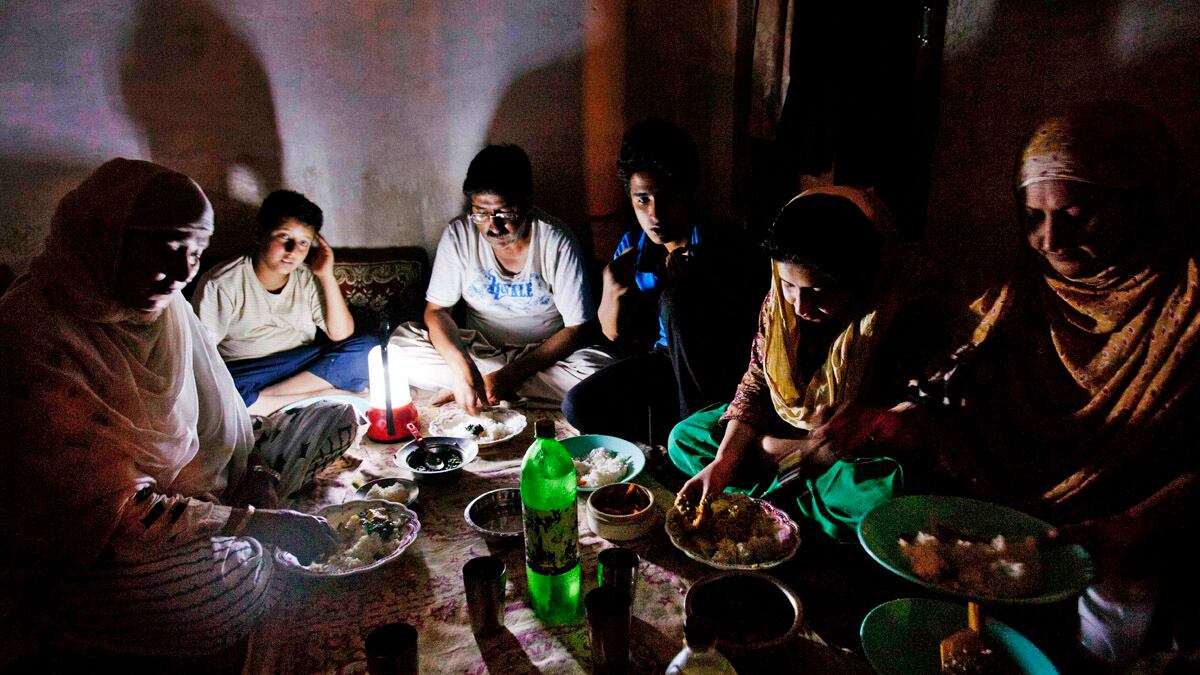While I was wandering about yesterday in Guwahati, in the northeastern state of Assam, a friend called. It was dusk. "There's no electricity," he said. I didn't need the reminder. It was a few hours into the power collapse across northern and eastern India and I was drenched in sweat.

My friend went on: "There's no point sitting inside somewhere, right, so why don't you join me for a walk?" We drove to a hill nearby. By the time we arrived, night had set in. We spent the next hour walking up and down the hill, a total of three times. It was a good workout, but the darkness was so complete that at one point, I nearly lost my footing and didn't know what I'd stepped in. Not that I wanted to know.
All through that panting hour, we could see a shimmering cornucopia of lights in the distance, like some fantastic Middle Earth castle. "Guwahati refinery," said my friend when I asked. "They have their own separate power supply." All right, I said, that seems reasonable. A refinery probably deserves uninterrupted power. But what about these lights in buildings and shops along the road that run at the base of the hill? How is it that they had electricity? I mean, if we hadn't known, it wouldn't have struck us that we were in the middle of a massive electricity shutdown: these lights were that numerous, that normal.
ADVERTISEMENT
"Hmm," said my friend. "I guess they all have generators."
The media has explored several facets of the far-reaching collapse of India's power grids this week. The shortage in production of electricity; the amount of electricity that's lost to theft; the way that Power Minister Sushil Shinde moved up the ranks to become Home Minister after the blackouts; the blame game being played between Indian states about which one drew more power; the lamentable state of that catch-all phrase "Indian infrastructure"; the blow this supposedly deals to our country's aspirations to become a superpower: all of it has been and will be argued and discussed endlessly. (Please don't miss the lone tweeter who's trying valiantly to make #SackShinde trend.)
But in many ways the real story of the collapse is that beyond the point where stalled Metro trains meet sweaty bodies like mine, the power collapse really did not affect a whole lot of Indians. One large fraction of the country never had electricity anyway. And another large fraction has good fall-back options in the form of generators and battery backup systems.
Especially in our large cities, though even in smaller ones like Guwahati, practically every major hotel and business operates generators. My friend's silk fabric showroom has one. Another friend's Ford dealership has a few. Many apartment blocks have them. Here's something to think about: for several hours, 20 states went without power, yet how many Indians stopped to wonder how cell phone networks still managed to function? Or how TV channels kept broadcasting the popular anger about the grid's collapse?
In Mumbai, you will even find valiant little Honda generators—chained so they won't be spirited away -- operating lighted advertisements ("Designer Skin From Kaya: Let Your Skin Talk") on bus shelters. The mouthwatering irony: both buses and electricity are supplied by the same municipal organization, the Brihan Mumbai Electric Supply and Transport, also known by its acronym, BEST.
The truth is that for hundreds of millions of Indians, power cuts are just part of life in this country, like brushing your teeth. We don't even think they are abnormal. What's a grid collapse for a few hours this week? After all, many of us live powerlessly for several hours every day, year in year out.
And in any case, to minimize any possible disruption to our lives from power cuts, we have these gadgets available. So we simply run and buy generators when we need them, like we might run and buy washing machines or flat-screen TVs. Just more consumer products, that's all.
And if you look at them that way, you could even start making a case for the benefits of losing electricity. Buying and selling stuff is the bedrock of the economy, after all. Therefore, it's probably safe to say that the generator business contributes a substantial chunk of change to the economy. Supply uninterrupted electricity to all and poof! There goes that chunk.
Who'd want that?
***
A few years ago, I found a good spot to truly appreciate the distribution of power in India. It was a beautiful stretch of beach south of Mumbai, leaning palms on one side, the gentle waves of the Arabian Sea on the other. It had taken us about three hours to drive there, but in a straight line, the great city is no further than the horizon. Through the evening haze, we could just see the vague shapes of the south Mumbai skyline.
As the sun set, my friend's house, nestled among palms, stayed dark. So did his entire village, Kihim, and indeed all the villages along this stretch of the coast. This was no accident. Between 2 p.m. and 8 p.m. every day, these villages get no electricity. Six hours every day, no electricity.
We strolled on the beach that night, waiting for the electricity to return, splashing in the water and watching the lights of Mumbai. In the gloom, the vague shapes of the city now twinkled. Even from this distance, it was a fetching sight. To our right, though, it was dark like it must have been at the time of, well, let's say Marcus Aurelius.
What does a Kihim resident think as she stands on her beach, powerless till 8pm, watching lights blink on in the big city? Does she wonder why she should be left behind by this thing called "development?" Does she marvel that she can actually see, only a few miles away, just how much she and her fellow villagers have been left behind?
Two days later, back in Mumbai, my morning newspaper brought news about three state ministers. The minister of energy had 10 air conditioners in his house and had run up electricity bills of almost $700 a month. Not to be outdone, the minister for rural development had nine air conditioners and bills exceeding that amount. The chief minister—no word on his count of air conditioners—had bills of more than $2,300 a month.
Taxpayer-paid bills, of course.
That Kihim resident, she won't ever get bills like those. Six hours a day without electricity will do that. Lucky lady.






